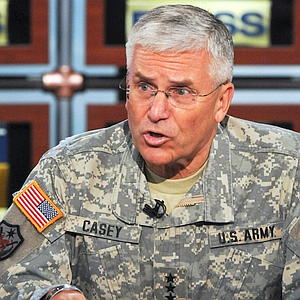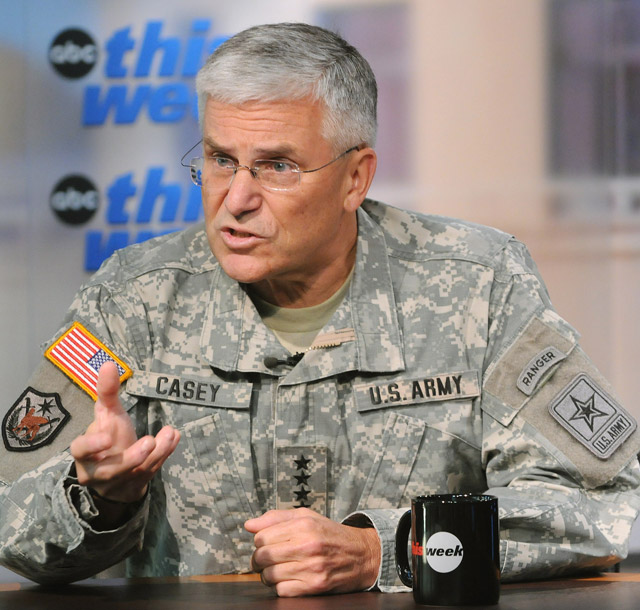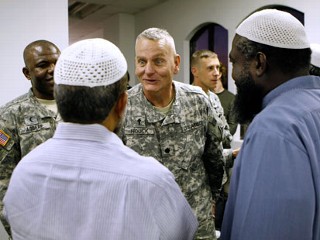|
Clothes make the Eloi
(Note: the discussion about today’s military uniforms continues in “Our nation’s chubby, shapeless guardians.”)
We have expressed outrage at George Casey for his insane liberalism.
But look at this photo:

How could we expect a man to have any sense of dignity and self-respect, how could we expect him to think clearly and rigorously, to have a serious attitude toward things, when he is dressed in those ridiculous pajamas that are the standard uniform not only of soldiers today, but of generals? Can you imagine Eisenhower, Marshall, and Patton, dressed like that? Would they have commanded the same respect if they had? Is not the military uniform of recent decades one of the devices whereby military personnel have been transformed into Eloi—chestless wonders and bureaucratized wimps who decline to report the presence of open traitors and jihad supporters in their ranks?
- end of initial entry -
Posted November 13
Re: Clothes make the Eloi
Bruce B. writes:
I don’t like the “pajama” uniforms either. I think the reason why privates AND generals wear them is that organizations now deemphasize hierarchy as part of the never-ending liberal attempt at leveling. I see it here in the private sector all the time. It’s total B.S. since human organization can’t function without hierarchy and dominance but they have to pretend to keep up appearances.
Howard Sutherland writes:
You also posted this photo of General George Casey, who—most unfortunately—is the Chief of Staff of the Army:
 The image you posted was more cropped than this one, which shows more of what is wrong with Casey’s turning out dressed this way for a major media television appearance (at, I would guess, a studio in Washington). So here, on the 234th birthday of the United States Marine Corps, are one former Marine officer’s random impressions of the appearance of this sad sack soldier in what may well be his most prominent public appearance. Or so I hope: may we be spared more of Casey’s diversity-mongering at the expense of training an Army fit to fight.
The image you posted was more cropped than this one, which shows more of what is wrong with Casey’s turning out dressed this way for a major media television appearance (at, I would guess, a studio in Washington). So here, on the 234th birthday of the United States Marine Corps, are one former Marine officer’s random impressions of the appearance of this sad sack soldier in what may well be his most prominent public appearance. Or so I hope: may we be spared more of Casey’s diversity-mongering at the expense of training an Army fit to fight.
The job of the Chief of Staff of the Army is to provide trained and equipped Army forces for the unified and specified commands that actually deploy soldiers in the field. He is the chief administrative officer of the Army, and is not, except for his own staff, a commander. He has no real field role. Whatever kind of fire-breathing warrior the Chief may have been earlier in his career (and Casey doesn’t strike me as that type, a type almost certain never to become a general officer in today’s Army anyway), while he is the Chief, he is a uniformed bureaucrat. It is absurd and would recently have been a clear violation of uniform regulations for an officer to appear in fatigues on a television program filmed in a Washington studio. It is the equivalent of showing up for a serious business meeting in coveralls. The Army has perfectly good service uniforms—even if soldiers are way too heavy on the merit badges—for the purpose. It is especially silly for the Chief of Staff, whose job is a coat-and-tie affair in the first place where it only really makes sense for him to sport fatigues when he is making morale-boosting visits to troops in the field. I have to wonder, though, just how many of the troops would find a visit from Casey a big morale-booster at the moment. It wouldn’t do much for me.
Also, for what it is worth, his eyeglasses are non-regulation (and why not wear contacts, anyway?). Those spindly, frameless numbers make him look like a civilian tax lawyer—not that I wish gratuitously to insult tax lawyers—and counteract the field-ready image Casey’s handlers are trying to present by putting him on TV in fatigues in the first place. I don’t know what the patch below the flag on Casey’s right shoulder stands for, but with its crossed scimitars and flying-camel looking beast, it looks pretty Islamic to me. Finally, note the patch below the Ranger tab on Casey’s left shoulder. It is not a time-honored insignia of the United States Army, but a Madison Avenue advertising logo the Army has been using in recent years to lure mestizo and Moslem mercenaries and other credulous girls and boys into joining the Army to fight in our Middle Eastern misadventures. So the Chief is appearing on TV as a billboard for Army recruiting. Below his pay grade, I would have thought.
All in all, today’s Chief of Staff of the Army, put together for television, strikes me as a very carefully assembled mess. Which, given how deliberately and assiduously political correctness and the putative merits of diversity uber alles are indoctrinated into American servicemen today, might not be a bad description of his state of mind. HRS
Daniel H. writes:
Subject General Dhimmi Casey:
 This photo is sickening. Look at the lackey expression on his face.
This photo is sickening. Look at the lackey expression on his face.
LA replies:
Yes, they’re dressed in their proud Muslim traditional outfits, and he’s wearing baggy pajamas and a silly expression. Can they be blamed for thinking we are dead meat?
John W. writes:
Well, if he wasn’t in the pajamas he’d be in something like this
November 14
Van Wijk writes:
Battle Dress Uniform (which you refer to as “pajamas”) has been worn by soldiers of every since Vietnam (here is a portrait of William Westmoreland). I wonder if the Army began its downward slide around that time.
LA replies:
That’s a dignified looking outfit and photograph. It’s not the type of uniform that came in, I don’t know exactly when, but it was certainly there by the ’80s, the camouflage outfit that looked like something for fighting in a jungle. And they began wearing these battle fatigues everywhere. Wherever soldiers were, they would be dressed as though they were fighting in a jungle. They never wore more dressy uniforms, they only wore those camouflage outfits, wherever they were. At the same time, the outfits have become more shapeless and baggy looking. I simply don’t understand how soldeirs could stand wearing them. Young men join the service because they want to be manly. How could someone feel manly when he’s dressed like a clown? Also, the baggy look seems to have been adopted because so many of the soldiers are overweight.
And of course Westmoreland would not have appeared in a TV interview or any formal event dressed in his battle dress uniform. He would have worn his service uniform. Now every level of the military wear the battle dress uniform in all circumstances.
Van Wijk writes:
You wrote: “It’s not the type of uniform that came in, I don’t know exactly when, but it was certainly there by the ’80s, the camouflage outfit that looked like something for fighting in a jungle.”
You’re thinking of the old Woodland pattern, adopted in 1981. You know what’s amusing, when the 2003 invasion of Iraq began, we were all wearing the newly issued Desert Camouflage Uniform (DCU), but everything else, from our Kevlar vests to our vehicles, was still in the Woodland pattern. We looked like perfect fools. I was discharged before the Army began to transition to the new, hideous digital pattern.
Now that I think of it, I think the all Battle Dress Uniform, all the time protocol came in around Desert Storm. I remember seeing Schwarzkopf wearing the DCU’s and nothing else. I think the Battle Dress Uniform was mandated for everyday use because of its simplicity, utility, and the fact that it was worn for field training, where conditions were harsh; they were ideal when you couldn’t change your clothes for several days or even weeks. So the Army could issues large amounts of a single, cheap uniform to each soldier. You’re right that there is a certain sloth involved; the dress uniform requires a great deal more maintenance than the BDU. And it certainly helped the fat soldiers to a degree. Note in this photo of Wesley Clark from the Bosnia era the buttoned straps on the waist of the tunic. The good general has absent-mindedly set his straps to the outer button, usually reserved for the obese in the ranks. I’m not sure if these straps are included on the new uniforms.
They’re ubiquitous on Army posts. Even the doctors wear them, inside the hospitals and out.
James P. writes:
Howard Sutherland says,
“Whatever kind of fire-breathing warrior the Chief may have been earlier in his career (and Casey doesn’t strike me as that type, a type almost certain never to become a general officer in today’s Army anyway), while he is the Chief, he is a uniformed bureaucrat. It is absurd and would recently have been a clear violation of uniform regulations for an officer to appear in fatigues on a television program filmed in a Washington studio. It is the equivalent of showing up for a serious business meeting in coveralls. The Army has perfectly good service uniforms—even if soldiers are way too heavy on the merit badges—for the purpose. It is especially silly for the Chief of Staff, whose job is a coat-and-tie affair in the first place where it only really makes sense for him to sport fatigues when he is making morale-boosting visits to troops in the field.”
I work in Washington and frequently visit the Pentagon, where the officers are ALL military bureaucrats who work in cubicles (the low) or offices (the high). Many, many officers wear BDUs (the camouflage outfits), and the pilots often wear flight suits. This could not be more ridiculous, since these officers could not be further from the field or the flight line than they are. When I see a three or four-star general in a flight suit, I want to ask, “When was the last time you actually flew an aircraft?”—but of course I don’t. The only way it could get more ridiculous is if they wore pistols or body armor as well.
Here is General Petraeus in the green service uniform and here in camouflage. You can see that the green service uniform is more suitable for someone in an office job, and certainly for appearing on TV or before Congress. Parenthetically, most of the ribbons you see on a General’s green service uniform will be “good bureaucrat” ribbons, not “valor in action” type ribbons. If a General appears on TV in the camo uniform, it is clearly because he chose to do so, perhaps to appear “more combatty” (rugged, ready for action) at least in his own opinion.
James P. continues:
Another ridiculous thing I forgot to mention is that the Air Force has its own “office worker” type uniform. However, the Air Force also has a baggy camo-type uniform—here you see a four star Air Force General wearing it. Camouflage uniforms are intended to make the wearer more difficult to see when he’s hiding in the woods and the enemy is shooting at him. Needless to say, Air Force people almost never do this. There are very few Air Force jobs for which this might be appropriate—perhaps base security guards and Special Operations troops. There is simply no chance that an Air Force General is going to be hiding in the woods with people shooting at him, and for such an officer to wear camouflage is the height of absurdity.
LA replies:
Amazing. the entire Pentagon, all X thousand officers working behind their desks in the Pentagon, all wearing camouflage suits!
Both the camouflage suits, and their ubiquitous use in place of normal service uniforms, have bothered me for many years, but I’ve never really talked about it, and now that I see I have some agreement, I’m thinking that a letter writing campaign to top military brass, to the Secretary of Defense and so on, might get them to think about something that they’ve probably never thought about before. People fall into fashionable attitudes, habits, and tastes, and then just take them for granted. Simply bringing to their attention the inappropriateness—and the demoralizing effects—of the current fashion could be enough to get them to think about it and maybe change it.
Tommy writes:
You had indicated in the comments section of “Clothes make the Eloi” that you were considering a letter writing campaign about the modern uniform’s impact on morale.
Here might be one more reason for the military into a different uniform: economics. Those state-of-the-art CDUs are expensive to manufacture. That’s why the IDF still has no mixed camoflague, let alone digital, patterns. Wearing these uniforms all of the time means repairing or replacing them frequently. If a solid color pattern were mandated for use outside the combat zone, the military and its personnel (who shoulder some of the cost of the uniforms) might save money.
November 15
Ferg writes: When I was on active service in the mid 1960s we were not even allowed to leave the post in duty uniform (fatigues, or battle dress) unless on a work detail . Even at National Guard summer camp same thing. Class A uniform or civvies if they were authorized, before leaving post. People who worked office desk jobs on post usually wore the Class A service uniform to work, except in training companies. We spent countless hours in basic training learning to be proud of how we looked. Even in fatigues, heavy starch, spit shined boots, polished brass buckle, battalion crest on hat. All the time, no exceptions. And we saluted every officer, every time.
November 16
JGP writes:
Another thought on this matter of Army personnel wearing battle dress at the office occurred to me. It’s no secret that office attire has become much more casual for all office workers in the last 20 years. Wearing jeans is acceptable and not only on Fridays. Could it be that this is the Army’s way of being hip and allowing “casual dress” at the office?
Perhaps even the military has succumbed to casual chic.
LA replies:
Oh, very much so. I believe that this change of military dress is primarily a countercultural expression. The service uniform is square, repressive, and boring. Fatigues are comfortable, expressive, and free.
November 16
James P. writes:
To continue the ridiculous military uniform thread, apparently the Navy has a camo uniform too, called the Navy Working Uniform.
Camouflage aboard a ship—think about that. Are there trees on a ship?
Here is what the wiki article says about it:
“Based on the U.S. Marine Corps MARPAT combat utility uniform, [JP: that is, it is based on the camo uniform of Marine ground troops who actually have a use for camo] with multiple pockets on the shirt and trousers, it uses a multi-color digital print pattern similar to those introduced by other services. [JP: “Similar to the other services” is what this is really all about. The Navy just couldn’t stand it that the other services had camo uniforms and they didn’t. I actually heard Navy officers grumbling about this back in the 1990s.] However, the NWU will also be made in three variants: predominately blue, with some gray, for the majority of sailors and shipboard use; [JP: blue and grey camouflage—absurd!] and a woodland digital pattern and a desert digital pattern for sailors serving in units requiring those types of uniforms. [JP: very, very few Navy units “require” camo in my view.] Woodland and desert variants may be tailored differently than the blue-pattern uniform.
The overall blue color reflects the Navy’s heritage and connection to seaborne operations. While not intended to disguise the wearer, [JP: there, we admit camo is stupid] the color pattern was chosen in part to harmonize with U.S. Navy ship colors and avoid presenting an obvious target when working aboard a vessel in port susceptible to infiltration by hostile forces. [JP: Absurd! How often has this happened? And since ships are a solid grey color, why not a uniform that is solid grey?] The pixelated pattern is also used to hide wear and stains, something unavoidable with the utilities and working khakis currently in use. [JP: Unavoidable and yet somehow the Navy has dealt with this problem for many decades] The colors were also chosen to match the most commonly used paint colors aboard ship, extending the lifetime of the uniform on long deployments where uniforms often come into contact with freshly painted surfaces. As of 2009, The uniform is unauthorized for wear outside of military installations with the exception of emergency situations or during working hours.”
LA replies:
James writes:
“The Navy just couldn’t stand it that the other services had camo uniforms and they didn’t.”
That’s what it’s all about it. We haven’t mentioned in this thread that it’s not just the U.S. that adopted the ridiculous camouflage look, but the military of just about every nation in the world. Once it became the fashion, everyone had to have it.
Posted by Lawrence Auster at November 10, 2009 10:35 AM | Send
|


